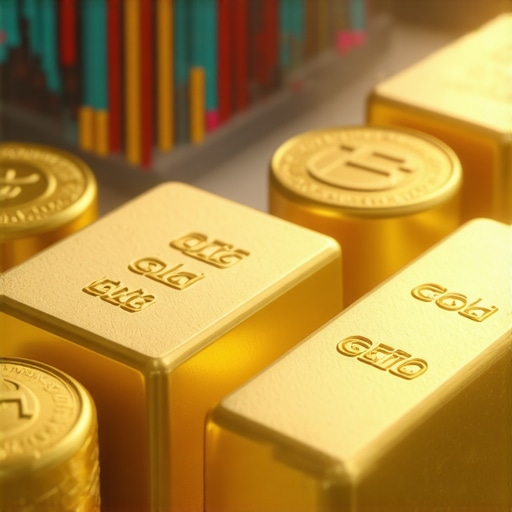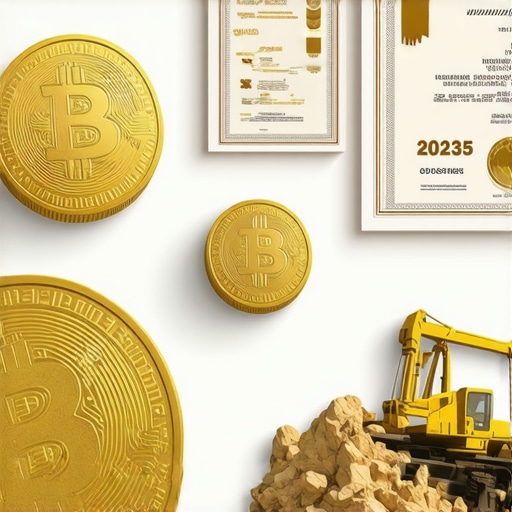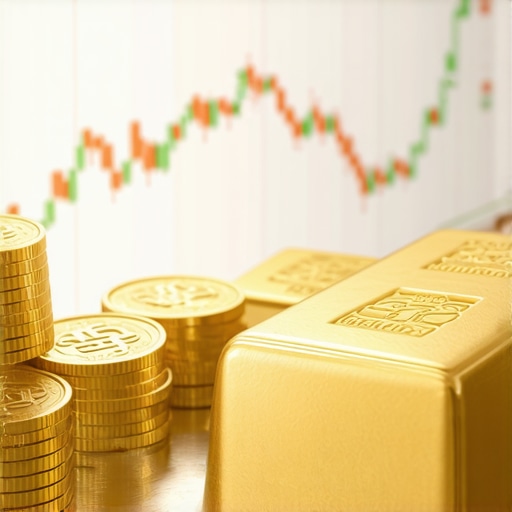How I Discovered the Allure of Gold Coins for Investing
When I first dipped my toes into investing in gold coins, I was both excited and cautious. Like many beginners in 2025, the idea of owning tangible wealth fascinated me—gold coins seemed like a perfect blend of history, beauty, and financial security. I remember holding my first American Gold Eagle coin, feeling the weight and the cool metal, which sparked a deeper interest in precious metals as a hedge against inflation and market volatility.
The Shiny Side: What I Loved About Investing in Gold Coins
One of the biggest pros I found with gold coins is their liquidity and recognizability. Unlike some other forms of gold investment, coins are widely accepted and easy to sell, which gives peace of mind. Plus, the collectible aspect adds a unique value layer beyond just the metal content. I also appreciated that coins come in various weights and designs, allowing me to start small and scale up gradually.
Another advantage I experienced is the relative ease of storage compared to bulky gold bars. Coins fit in a safe deposit box or a home safe without taking up much space. For anyone interested in physical gold, understanding the nuances between coins and bars is crucial—if you want to dive deeper, this guide on choosing physical gold bars vs coins helped me make informed decisions.
What Are the Main Challenges I Faced Investing in Gold Coins?
Of course, investing in gold coins isn’t without its hurdles. One challenge I encountered was the premium over spot price—coins often cost more than pure bullion due to minting and collectible value. This means that if you need quick cash, you might not recoup the full premium. Additionally, verifying authenticity is critical to avoid scams, especially for beginners. I learned to rely on trusted dealers and certifications, which is why reading up on how to select trusted gold dealers was a game-changer for me.
Another con is price volatility influenced by market demand and geopolitical events. Gold prices fluctuate based on complex supply and demand dynamics that even experienced investors monitor closely. For instance, the recent shifts in gold demand due to global economic uncertainty highlighted in this market analysis really opened my eyes to how interconnected these factors are.
Why I Believe Gold Coins Still Deserve a Spot in Your Portfolio
Despite the cons, my experience tells me that gold coins are a valuable part of a diversified investment strategy. They provide a tangible hedge against inflation and currency risks, which is especially important in today’s unpredictable economic environment. Plus, the historical and sentimental value adds a personal dimension to investing that stocks or ETFs just can’t match.
For beginners curious about starting their own gold coin collection or investment, I recommend combining physical gold like coins with digital assets such as gold ETFs or mutual funds to balance liquidity and security. The insights in understanding types of gold investments helped me find that balance.
If you’re already investing in gold coins or thinking about it, I’d love to hear your experiences or questions. Let’s share tips and stories in the comments below to help each other navigate this glittering world of precious metals!
For those wanting to dive deeper into safe and strategic gold investing, the World Gold Council remains an authoritative resource. Their research on gold’s role as a financial safe haven really reinforced my faith in gold coins as more than just shiny collectibles (gold.org research).
Advanced Strategies for Maximizing Gold Coin Investment Returns
After gaining initial experience with gold coins, I realized that a tactical approach is essential to truly harness their investment potential. One key strategy is timing purchases around market dips, as gold prices can be volatile due to global economic events and geopolitical tensions. Using reputable market analysis tools and reports, such as those found in the gold market analysis, helped me identify optimal entry points and avoid overpaying during price surges.
Another tactic involves diversifying across different coin types and mints. For instance, combining popular bullion coins like the American Gold Eagle with less common but highly collectible coins can balance liquidity with potential premium appreciation. This diversification also reduces exposure to any single market segment’s fluctuations.
How Can Investors Balance Collectible Value and Market Liquidity in Gold Coins?
This balance is a nuanced challenge. Collectible coins often carry premiums reflecting rarity, design, and historical significance, which can be profitable if held long-term. However, these premiums reduce immediate liquidity and can complicate quick sales. I recommend investors maintain a portion of their portfolio in widely recognized bullion coins, which trade closer to spot prices and are easier to liquidate. Meanwhile, allocating a smaller portion to collectible coins allows for potential value appreciation without compromising overall portfolio flexibility.
Understanding dealer buy-back policies and market demand for specific coins is also critical. Engaging with trusted dealers, as discussed in how to select trusted gold dealers, ensures fair pricing and reduces the risk of holding illiquid assets.
The Role of Economic Indicators in Shaping Gold Coin Investment Decisions
Tracking economic indicators like inflation rates, currency strength, and central bank gold purchases offers predictive insights that seasoned investors leverage. For example, rising inflation typically boosts gold’s appeal as a hedge, often increasing coin demand and impacting premiums. Additionally, geopolitical uncertainties tend to trigger safe-haven buying, which can temporarily inflate prices.
I found it invaluable to monitor reports from authoritative sources such as the World Gold Council and financial news outlets to stay ahead of these trends. Keeping abreast of factors influencing gold supply and demand, including mining outputs and recycling rates, enables more informed decisions on when to buy or sell physical gold.
For a deeper dive into these dynamics, consider exploring understanding gold supply and demand trends which offers comprehensive insights.
Integrating Gold Coins Into a Broader Investment Portfolio
While gold coins provide tangible asset security, integrating them with other asset classes can optimize portfolio resilience and growth. Pairing physical gold with ETFs, mutual funds, or even gold mining stocks can offer a blend of liquidity, income potential, and capital appreciation.
In my experience, this balanced approach mitigates risks associated with holding physical assets exclusively, such as storage concerns and premiums. Moreover, combining gold coins with digital gold investments provides flexibility to adjust exposure quickly in response to market shifts.
For those interested in portfolio construction techniques, resources like how to build a balanced gold portfolio with ETFs and stocks provide practical frameworks to tailor investments according to individual risk tolerance and financial goals.
When Does Emotional Attachment Become a Double-Edged Sword in Gold Coin Collecting?
Reflecting on my journey, I realize that the sentimental value attached to gold coins can be both a blessing and a challenge. Holding a coin that commemorates a historic event or features a beloved design often deepens my connection to the investment, making it more than just a financial asset. Yet, this emotional attachment sometimes clouds judgment, especially when market conditions suggest selling but my personal affinity urges me to hold on.
This duality is something many investors grapple with. It reminds me of the delicate balance between passion and pragmatism. For those curious, exploring how to balance collectible allure with sound investment decisions is key—resources like choosing between gold bullion and gold coins for investment insights provide useful perspectives that helped me navigate this.
How Do Shifts in Global Economic Policies Influence Gold Coin Valuations?
Understanding macroeconomic shifts has become increasingly important in my gold coin investment strategy. For instance, recent changes in central bank policies around the world, including gold buying trends, have nuanced effects on coin premiums and demand. Such policies can signal larger economic shifts, influencing not just spot prices but also collectible premiums.
Monitoring these shifts through expert analyses, like those from the World Gold Council and the latest market analysis of global events impacting gold prices, has sharpened my timing on both acquisitions and sales. It’s fascinating how geopolitical tensions or trade negotiations ripple through the precious metals market, often unpredictably.
Why Does Storage Security Become More Critical as Your Gold Coin Collection Grows?
Early on, storing a few coins felt straightforward. But as my collection expanded, so did the challenges. Ensuring physical security, insurance coverage, and discreet storage became priorities that required thoughtful planning. I learned to evaluate storage options ranging from high-security home safes to bank safety deposit boxes, weighing convenience against risk.
Additionally, understanding how to document and insure your collection properly is crucial. This not only protects your investment but also helps in estate planning and potential resale. For those looking to deepen their knowledge, the guide on safe physical gold storage tips was instrumental for me.
What Advanced Tactics Can Help Investors Optimize Timing in the Ever-Volatile Gold Market?
Timing the market remains a complex art and science. Beyond watching economic indicators, I’ve found value in leveraging advanced tools like futures contracts and options to hedge risks or speculate strategically. While these instruments aren’t for everyone, learning about mastering gold futures trading techniques opened new horizons in managing exposure and capitalizing on short-term price movements.
Furthermore, keeping a pulse on supply and demand dynamics through detailed reports, such as those in understanding gold supply and demand trends, has helped me anticipate market swings more confidently. Combining these insights with a well-diversified portfolio helps cushion against volatility while seizing growth opportunities.
I’d love to hear how you balance the emotional and strategic sides of gold investing. Have you faced moments where your heart and your portfolio goals clashed? Share your stories or questions below so we can learn and grow together in this luminous journey.
Embracing Emotional Intelligence in Gold Coin Investment Decisions
Over time, I’ve realized that investing in gold coins is as much an emotional journey as it is a financial one. The allure of unique designs and historical significance often creates a personal connection to each piece, transforming a simple asset into a cherished keepsake. This emotional layer enriches the investment experience but also introduces the risk of attachment clouding objective decision-making. I’ve learned through experience that cultivating emotional intelligence—recognizing when sentiment might compromise strategy—is essential for maintaining portfolio discipline.
One technique I use is setting predefined criteria for buying and selling, which helps counterbalance the urge to hold onto a coin purely for sentimental reasons. Incorporating this emotional awareness alongside rigorous market analysis ensures that my gold coin collection remains both meaningful and financially prudent. For those navigating this delicate intersection, exploring insights on choosing between bullion and coins offered me valuable perspectives on balancing passion with pragmatism.
The Strategic Edge: Leveraging Global Economic Shifts to Enhance Gold Coin Portfolio Value
Delving deeper into macroeconomic influences, I’ve observed how subtle shifts in global policies can dramatically reshape gold coin valuations. Central bank gold purchase trends, trade negotiations, and geopolitical tensions don’t just affect spot prices—they ripple through premiums attached to collectible coins. Staying attuned to these undercurrents allows me to time acquisitions and divestitures with greater precision, aligning my portfolio with emerging global narratives.
For instance, when significant central banks increase their gold reserves, demand surges, often leading to tighter supplies and elevated premiums on rare coinage. Conversely, easing geopolitical friction can temporarily suppress safe-haven demand, creating entry points for selective buying. Leveraging authoritative analyses, like the latest market analysis of global events impacting gold prices, has been indispensable in decoding these complex dynamics and refining my investment timing.
How Can Advanced Investors Utilize Futures and Options to Complement Physical Gold Coin Holdings?
Recognizing the limits of physical assets, I ventured into integrating derivatives such as futures and options to hedge risks and capitalize on short-term market movements. These financial instruments, while sophisticated, offer powerful mechanisms to manage exposure without liquidating prized physical holdings. Through diligent study and practice, including resources like the mastering gold futures trading techniques, I’ve enhanced my ability to navigate price volatility and lock in gains strategically.
This hybrid approach—melding tangible collectibles with tactical market instruments—provides a dynamic framework that balances stability with agility. It demands continuous education and vigilance but yields a more resilient and responsive portfolio, especially amid 2025’s unpredictable economic landscape.
If you’ve navigated similar complexities or are curious about integrating these advanced strategies, I invite you to share your experiences or questions below. Together, we can deepen our understanding and mastery of gold coin investing’s multifaceted art.
Things I Wish I Knew Earlier (or You Might Find Surprising)
The Emotional Rollercoaster Is Real
When I started collecting gold coins, I underestimated just how much emotional attachment would influence my decisions. Each coin felt like a trophy, a story frozen in time, which made it tough to sell even when market conditions suggested I should. Recognizing this early on and learning to separate sentiment from strategy would have saved me some heartache and helped me stick to my investment goals.
Not All Gold Coins Are Created Equal
I initially thought all gold coins would behave similarly in terms of liquidity and pricing, but that’s not the case. Some coins carry hefty premiums due to rarity or design, which can be a double-edged sword. Understanding the balance between collectible coins and bullion coins is crucial. If you want to keep liquidity, focusing more on widely recognized bullion like American Gold Eagles or Canadian Maple Leafs might be wiser.
Storage Is More Than Just a Safe Place
Early in my journey, I stored my coins in a simple home safe and thought that was enough. Over time, I realized the importance of insurance, secure documentation, and even discreet storage to protect against theft or damage. It’s a part of investing that’s easy to overlook but can cost dearly in the long run.
Timing and Market Awareness Matter More Than I Expected
Gold prices can fluctuate with global events, inflation reports, and geopolitical tensions. I learned the hard way that jumping in without monitoring these factors can lead to overpaying or missed opportunities. Regularly following trusted market analysis and understanding supply-demand trends has become a cornerstone of my strategy.
Combining Physical Gold with Other Assets Strengthens Your Portfolio
While gold coins provide a tangible and beautiful investment, pairing them with gold ETFs, mining stocks, or mutual funds adds flexibility and growth potential. This hybrid approach not only cushions against volatility but also allows me to adjust exposure quickly without liquidating physical assets.
Resources I’ve Come to Trust Over Time
World Gold Council – Their comprehensive research and market insights have been invaluable in understanding gold’s role as a safe haven and the macroeconomic forces at play. I often recommend their site to friends who want a clear, authoritative perspective (gold.org research).
BuyingGoldNow.com Guides – From picking trusted dealers (how to select trusted gold dealers) to mastering gold futures (essential trading techniques), their practical advice helped me avoid pitfalls and refine my strategies.
Financial News Outlets – Staying updated with outlets that cover global economic policies and their impact on precious metals helped me grasp the bigger picture behind price movements, especially during uncertain times.
Parting Thoughts from My Perspective
Investing in gold coins has been a rewarding blend of financial savvy and personal passion for me. The tactile joy of holding a coin rich with history, combined with its role as a hedge against economic turbulence, creates a unique investment experience. However, it requires more than just enthusiasm—it demands ongoing education, emotional discipline, and strategic thinking.
If you’re considering adding gold coins to your portfolio, my biggest advice is to embrace a balanced approach: educate yourself about market dynamics, diversify across physical and digital gold assets, and keep your emotions in check. This strategy helped me turn what began as a hobby into a meaningful component of my wealth preservation plan.
If this resonated with you, I’d love to hear your thoughts or experiences. Feel free to drop your own stories or questions in the comments below—let’s learn and grow together in this fascinating journey of gold coin investing!











Reading through this post really resonated with my own experience starting out in gold coin investing. The emotional aspect especially hits home — I remember my first coin, a Canadian Maple Leaf, which I bought partly because of its purity and partly for its aesthetic appeal. I quickly learned that while the physicality of gold is compelling, understanding market dynamics and premiums is vital. One thing I’ve found helpful is regularly educating myself through trusted resources like the World Gold Council, which the post mentions.
A question I have for others in this space: how do you suggest balancing the allure of collecting rare coins with the need for liquidity, especially if your collection grows significantly? Do you focus mainly on bullion coins for easier resale, or do you see value in maintaining a portion of collectible items for potential premiums? I’d love to hear strategies from more experienced investors on this.
This post really hit home for me, especially the part about balancing collectible value with liquidity. I’ve been collecting a mix of American Gold Eagles and some commemorative coins, and I find that while the Eagles are highly liquid and easy to sell, the collectible coins can sometimes carry hefty premiums but are harder to offload quickly. Navigating this balance is tricky—I wonder how others decide what to keep for the long term versus what to sell when the market peaks. It’s a real strategic challenge, and I’m curious if anyone prioritizes maintaining a core of bullion coins for cash flow needs, or if most investors lean towards accumulating rare pieces over time.
Also, I’d love to hear how recent economic shifts, like inflation or geopolitical tensions, affect your buying and selling timing. Do you set specific targets or rely more on market signals? Every perspective helps shed light on managing a gold coin portfolio smartly in this unpredictable environment.